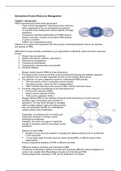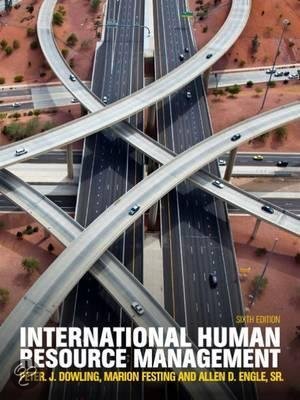International Human Resource Management
Chapter 1 Introduction
HRM characterized by three broad approaches:
- Cross-cultural management. examining human behaviour
within organizations from an international perspective.
important when dealing with cultural aspects of foreign
operations.
- Comparative industrial relationships and HRM systems.
Seeks to describe, compare and analyse HRM systems
in various countries
- IHRM in the multinational context
Objective is to explore the implications that the process of internationalization has for the activities
and policies of HRM.
HRM refers to those activities undertaken by an organization to effectively utilize its human resources.
Include:
1. Human resource planning
2. Staffing (recruitment, selection, placement)
3. Performance management
4. Training and development
5. Compensation (remuneration) and benefits
6. Industrial relations
Morgan model presents HRM on three dimensions:
1. The broad human resource activities of procurement (HR planning and staffing), allocation
and utilization (can be easily expanded into the six HR activities listed above)
2. The national or country categories involved in international HRM activites:
The host-country, where a subsidiary may be located
The parent-country, where the firm is headquartered.
Other countries that may be the source of labor, finance and other inputs
3. The three categories of employees of an international firm:
Host-country nationals (HCNs)
Parent-country nationals (PCNs)
Third-country nationals (TCNs)
Morgan defines IHRM as the interplay among the three dimensions of human resource
activities, type of employees and countries of
operations. The way which diversity is managed
within a single national, legal and cultural context
may not necessarily transfer to a multinational
context without some modification.
Expatriates, an employee who is working and
temporarily residing in a foreign country
(international assignees).
Inpatriate, has come into vogue to signify the
transfer of subsidiary staff into the parent country
operations.
Defining the field IHRM:
Broadly to cover all issues related to managing the global workforce and its contribution
to firm outcomes
Covers wide range of human resource issues facing MNEs in different parts of their
organizations
Include comparative analyses of HRM in different countries.
Difference between domestic and international HRM
Complexity of operating in different countries and employing different national categories of
works is key variable that differentiates domestic and international HRM.
Dowling argues that complexity of IHR can be attributed to six factors:
,1. More HR activities
2. The need for broader perspective
3. More involvement in employees’ personal lives
4. Changes in emphasis as the workforce mix of expatriates and local varies
5. Risk exposure
6. Broader external influence
More HR activities
Operate international environment, HR department must engage in number of activities not
necessary in domestic environment. Examples require international requirements:
International taxation
Tax equalization policies must be designed to ensure that there is no tax incentive of
disincentive associated with any particular international assignment.
International relocation and orientation
Following activities:
Arranging for pre-departure training
Providing immigration and travel details
Providing housing, shopping, medical care, recreation and schooling information
Finalizing compensation details such as:
o delivery of salary overseas
o determination of various overseas allowances
o taxation treatment.
Administrative services for expatriates
Providing these services can be time-consuming and complex activity because policies
and procedures are not always clear-cut and may conflict with local conditions.
Host-government relations
Represent an important activity in HR department in MNE, in developing countries
where work permits and other important certificates are often more easily obtained when
a personal relationship exists between the relevant government officials and
multinational managers.
Language translation services
The need for a broader perspective
Because HR managers working in an international environment face the problem of
designing and administering programs for more than one national group of employees, they
need to take a broader view of issues.
Complex equity issues arise when employees of various nationalities work together, and the
resolution of these issues remains of major challenges in the IHRM field.
More involvement in employees’ personal lives
Greater degree of involvement in employees’ personal lives is necessary for the selection,
training and effective management of both PCN and TCN employees. The psychological
contract is now between the MNE and the entire immediate family of the international
assignee (need to know more about their lives because of support that is required)
Risk exposure
Human and financial consequences of failure in international are more severe. Another
aspect is terrorism, HR department may need to devise emergency evacuation procedures
for highly volatile assignment locations subject to political or terrorist violence, or major
epidemic or pandemic crises.
Broader external influences
Major external factors that influence IHRM are:
Type of government
State of the economy
Generally accepted practices of doing business in each of the various host countries in
which MNEs operate.
, Variables that moderate differences between
domestic and international HRM.
Four variables that moderate difference:
1. The cultural environment
2. The industry (or industries) with which the
multinational is primarily involved
3. The extent of reliance of the multinational on its
home-country domestic market
4. The attitudes of senior management.
Cultural environment
Culture is used to describe a shaping process
over time
generates relative stability, reflecting a shared knowledge structure that reduces
variability in values, behavioural norms and patterns of behaviour.
Characteristic is that it is so subtle a process that one is now always conscious of its
relationship to values, attitudes and behaviour
culture shock is a phenomenon experienced by people who move across cultures. New
environment requires fast adjustments, challenging people’s frames of reference to such an
extent that their sense of self (nationality) comes into question. People experience shock
reaction to new cultural experiences that cause psychological disorientation because little
they misunderstand or do not recognize important cures Can lead to negative feelings about
host country and its people and longing to returning home.
Problems in cross-cultural and comparative research:
Little agreement on either an exact definition of culture or on the operationalization of
this concept.
Emic-etic distinction. (legitimate research orientations)
Emic refers to culture-specific aspects of concepts or behaviour
Etic refers to culture-common aspects.
Methodological difficulties may arise if the distinction between these two approaches is
ignored or if unwarranted universality assumptions are made.
Cultural awareness and the role of the international HR manager
Coping with cultural differences, and recognizing how and when these differences are
relevant, is a constant challenge for international firms. Helping to prepare assignees and
their families for working and living in a new culture environment has become a key activity
for HR departments in those MNEs that appreciate the impact that the cultural environment
can have on staff performance and well-being
Industry type
Porter suggest that industry in which a MNE is involved is of considerable important because
patterns of international competition vary widely from one industry to another.
Multidomestic industry, which competition in each country is essentially independent of
competition in other countries.
Global industry, in which a firm’s competitive position in one country is significantly
influenced by its position in other countries.
Key distinction between Multidomestic and global according to porter:
Global industry is a series of linked domestic industries in which rivals compete against each
other worldwide basis. Multidomestic collapses to a series of domestic strategies
HRM function is seen as cutting costs across the entire value chain of a firm:
Multidomestic industry, role of HR department be more domestic in structure and
orientation. Support the primary activities of the firm in each domestic market to achieve
a competitive advantage through either cost/efficiency or product/service differentiation
Global industry, HRM function structured to deliver the international support required by
the primary activities of the MNE.
, Laurent noted: in order to build, maintain and develop their corporate identity, multinational
organizations need to strive for consistency in their ways of managing people on a
worldwide basis. In order to be effective locally, need to adapt to those ways to specific
cultural requirements of different societies. Global industry increased consistency, variety
cultural environments call for differentiation. According to Laurent, HR managers need to
see that their way of managing reflects their own culture; that your own way of managing is
not always universally effective; implies the preferred way of managing; and has had cross-
cultural learning and so did the employees.
Index of transnationality, is an average of ratios of foreign assets to total assets; foreign
sales to sales sales; and foreign employment to total employment.
Attitudes of senior management to international operations
Senior management doesn’t have strong international orientation, importance of
international operations underemphasises in terms of corporate goals and objectives.
managers focus on domestic issues and minimize differences between international and
domestic environments.
Failure to recognize differences in managing HR in foreign environment and lack of
international perspective lead to major difficulties in international operations.
Applying strategic view of IHRM
Assumes that MNEs operate in contest of worldwide
conditions, including the influences of industry and
regional, national, and local markets that include
geopolitical, legal, socio-cultural, and economic
characteristics.
PESTLE (political, economic, sociological,
technological, legal, environmental) used to describe
macro-environment. External factors direct influence
on both internal/organization factors and SHRM
strategy and practices and that external factors have
a direct influence on MNE performance.
Other external factors:
Organizational links with other MNEs and National government
Assymetric events (threats that our politic, strategic, and militart cultures regard as
unusual.
Unmatched in our arsenel of capabilities and plan
High leveraged against our particular assets
Designed not only to secure leverage against assets, also to intended to work
around, offset, and negate what in other contexts are our strenghts
Difficult to respond to in a discriminate and proportionate manner
Environmental dynamics
Operational factors:
MNE balance of global integration and local responsivenesss. Refers to extent to which
MNEs can maximize local responsiveness and also integrate units into cohesive, global
organization
MNE structure. Mechanisms of co-ordination and mode of entry into foreign markets
Firm size and maturity. May influence decisions with respect to HRM
MNE strategy, well-documentad, organization strategy
Corporate governance. Issues related to ethical principles and values
Headquarters international ortientation. Extent and dicersity of experience
Organizational culture, the sense of common identity and purpose across the whole
organization and is the final organizational factor included in the framework
Model by de Ciere and Dowling aims to assist in the cross-fertilization of ideas to further
develop theory and empirical research in strategic HRM in multinational firms.






